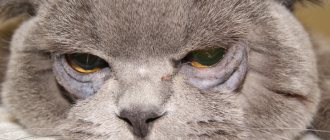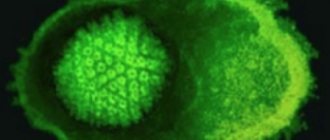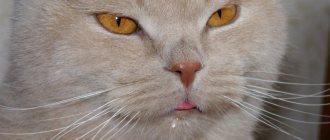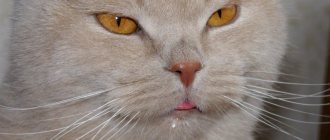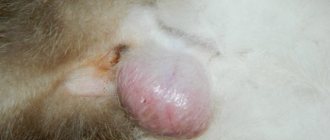It so happens that cats suffer from approximately the same diseases as people. They often face the problem of tartar deposits. What is tartar? These are calcareous deposits with a fairly stable structure that grow quickly and give the tooth a yellow or dark brown color.
Content
1. How to recognize a cat’s tendency to this disease? 2. Tartar in cats: symptoms and consequences 3. How to remove tartar in a cat 4. How to treat tartar in a cat? 5. Removing tartar from a cat at home 6. Prevention of tartar in cats
Tartar in cats is a very insidious disease that can occur completely unnoticed by the owners in the initial stages. It is extremely difficult to identify a problem at an early stage, but it is even more difficult to correctly prevent its occurrence.
As a rule, tartar in a cat is formed as a result of insufficiently thorough, irregular oral hygiene. The consequence of this is the appearance of an animal-like foul odor in the mouth, as well as painful sensations when chewing food. If you ignore this problem for too long, your beloved pet may lose its teeth completely. To prevent this from happening, you should stock up on at least basic knowledge about this dangerous disease.
Tartar is a dense, hard plaque that accumulates due to the vigorous activity of microorganisms. The accumulation of lime is rough to the touch and has a cloudy brown color. This problem is mainly observed in pets under one year of age. At an early stage of development, tartar accumulates as a result of the accumulation of pathogenic microorganisms on the surface of the animal’s fangs. As a result, the teeth are affected by hard particles that grow over time.
The main prerequisites for the formation of tartar in cats include:
- presence of rotten teeth;
- inflammatory processes affecting the gingival mucosa;
- absence of at least one antagonist tooth;
- impaired metabolism of minerals (leads to an imbalance of phosphorus and calcium).
Veterinarians also name several factors that increase the risk of developing the disease:
- wrong choice of cat food;
- lack of solid natural food in the animal’s diet that can remove plaque naturally;
- irregular and insufficiently thorough oral hygiene of the pet (or its absence in principle).
Causes
The following are the reasons for the formation of dentolits:
- Inflammation of the gums.
- Dental diseases.
- Loss of one of the opposing fangs.
- Increased mineral metabolism.
- Feed exclusively wet food.
- Congenital roughness of teeth.
- A plaque forms, which gradually hardens
Predisposing factors for the formation of dental stones are considered to be a deficiency of Ascorbic acid or an increased need for it due to an infectious disease. An unfavorable background is created by prolonged use of steroidal antiphlogistics, which destroys collagen fibers.
Types of stones
Dentoliths form mainly where a lot of saliva is produced - on the lower incisors and molars. There are superficial stones, clearly visible and hidden, formed on the root of the tooth.
Danger of dentolitis
With improper nutrition, dental plaque forms, gradually mineralizing and hardening. Only a veterinary dentist can rid a cat of an unpleasant formation. Unremoved dentoltitis grows, leading to gingivitis and tooth loss.
Gingivitis
How to recognize a cat’s tendency to this disease?
If previously tartar was considered a disease characteristic of older cats, today it is increasingly detected in young animals. Most experts believe that the reason for this trend is an unbalanced diet, which leads to disruption of many metabolic processes.
Veterinarians identify risk groups that include certain breeds of cats that are susceptible to developing tartar. The owners of the Persians, British and Scots should be wary. The tendency to this disease among the named breeds is caused by the negligent attitude of low-skilled breeders towards their gene pool.
Semi-feral and barn cats, accustomed to eating exclusively natural food, are much less susceptible to the formation of tartar and other oral diseases. The reason for this is a much stable immunity compared to purebred relatives.
However, it is possible to protect your pet from such an unpleasant problem. The most important thing is to be careful and not delay visiting the veterinarian at the first suspicion that your animal has this disease.
Risk group
The Murkoshi team points out that there are features that increase the chance of dental plaque in some cats. This:
- Metabolic disorders - excess salts and trace elements in saliva lead to accelerated layering and hardening of plaque. Congenital pathology.
- Malocclusion is a congenital phenomenon; the deposits cannot be removed by natural friction of the teeth.
- Increased enamel roughness is an individual feature.
- Popular breeds - Siamese, Persian, British Fold and Scottish - are generally prone to disease (which does not mean that any member of one of these breeds will necessarily be predisposed to disease).
Tartar in cats: symptoms and consequences
The most common manifestations of the disease include:
- the presence of a foul odor from the cat’s mouth;
- growths on the surface of the fangs, the origin of which is unknown;
- frequent inflammation of the gums;
- hot temper, aggressiveness, frequent growling of the animal and other manifestations of behavior unusual for a cat;
- intense secretion of saliva;
- unstable and loose teeth that are prone to falling out;
- the cat's tendency to rub its cheek on any surface;
- visible plaque on the teeth that is yellow or brownish in color;
- swelling of the oral mucosa;
- swelling of the eyelids;
- loss of appetite.
To effectively remove tartar, the owner needs to take the pet to the veterinarian. Only a specialist, after a thorough examination of the animal’s oral cavity, can determine the nature and stage of development of the disease. Refusal to visit a specialist and qualified treatment can lead to serious complications of dental plaque, namely:
- initial stage of periodontal disease (gingivitis);
- infectious lesions of the gums, fraught with tooth loss (periodontal disease);
- inflammatory processes that cause unbearable pain in the animal (pulpitis);
- bacterial infection of the teeth and oral cavity (stomatitis).
Symptoms
If you notice the following symptoms in your pet, contact your veterinarian immediately:
- the cat constantly shakes its head, as if trying to independently free itself from some foreign body;
- a strong unpleasant smell of rotting emanates from the mouth;
- soreness, redness, bleeding gums;
- brown and yellow deposits on teeth;
- the cat eats little, shows anxiety, or completely refuses food due to painful sensations similar to pulpitis.
Neglected cases lead to caries, gingivitis, stomatitis, periodontal disease, as well as diseases of the nasolacrimal ducts and ears.
How to remove tartar from a cat
Removing tartar from a cat is a procedure that causes significant discomfort to the animal. In the absence of complications, the process takes from 40 minutes to an hour. In most cases, veterinary clinics offer step-by-step teeth cleaning, which ensures the highest quality removal of growths. It is extremely important to address this problem to a reliable clinic with high-class specialists. If cleaning is not done thoroughly enough, re-formation of tartar on the teeth cannot be avoided.
Tartar can be removed from a cat using special dental devices and equipment.
Currently practiced:
- ultrasonic stone removal (effective for removing small plaque particles);
- treatment of teeth with grinding and polishing pastes.
Owners of old and weakened pets who are unable to confidently tolerate general anesthesia should prepare for multi-stage treatment of the animal under the influence of painkillers. In this case, cleaning tartar in cats is carried out gradually, which will require more than one visit to the veterinarian.
Elimination of plaque does not at all indicate that the treatment has come to an end. Remember: even after complete removal of tartar, your pet will still need care. Your veterinarian will provide recommendations regarding pain medications that you can give your cat on your own. You should also temporarily replace your usual solid foods with semi-liquid ones.
How to identify and treat pathology?
Detection of calcareous deposits on teeth is carried out during a routine examination by a veterinarian using a special mirror. The doctor must check for inflammation, damage, and tumors in the oral cavity.
After the examination, therapy is prescribed, during which the cat’s tartar is removed. It is best to give preference to specialists in this matter. Home remedies do not always help cope with pathology. With their help it is better to prevent the disease.
You can remove tartar from your cat's teeth using the following methods::
- Mechanical. This method involves the use of dental instruments to remove the stone. This procedure can damage the teeth if the doctor is not careful or the cat starts to struggle.
- Ultrasonic. This method is considered safer. It consists in cleaning the tartar from a cat’s teeth using an ultrasonic machine.
Currently, veterinarians prefer to remove the stone in three stages:
- Chipping of a formation from a tooth.
- Cleaning the jaw with ultrasound.
- Final teeth grinding.
There should be no stone residue left behind. Otherwise it will arise again. All of these methods cause pain to the cat, so removal is performed using anesthesia. Treatment takes approximately 30-40 minutes.
© shutterstock
How to treat tartar in a cat?
In large cities, most veterinary clinics have equipment designed for ultrasonic plaque removal. This method of treatment is expensive and requires the animal to be placed under general anesthesia (alternatively, medicated sleep).
In the absence of the necessary equipment, clinics practice a simpler method of treatment - removing tartar using special dental instruments. This technique can be stressful for the animal: the cat must be well secured in a comfortable position, and then anesthesia must be applied. Not every pet is able to withstand a painful procedure.
Before the procedure, the gum edge and teeth are isolated from saliva using a cotton swab soaked in an iodine solution. Small growths are treated with lactic acid and removed mechanically after some time. To do this, the veterinarian uses a special brush soaked in a sodium bicarbonate solution.
What is tartar on dogs' teeth?
The process begins with the appearance of plaque on the enamel of the front surface of the teeth or at the very gums. The mass consists of food debris mixed with saliva and serves as an excellent environment for the development of bacteria. Over time, this mixture compacts, and after 4-6 months it hardens to the state of stone.
A dog with healthy teeth feels great
For your information! Initially, the color of the soft coating is light yellow. As it hardens, it darkens, becoming dark brown or even black.
Possible reasons for the appearance
There are several reasons why tartar appears on dogs' teeth. Here are the most common ones:
- poor nutrition;
- violation of water-salt metabolism;
- acidity level in saliva;
- sugar abuse;
- malocclusion and other problems of dental structure;
- lack of hygiene procedures.
Preventive actions boil down to identifying what caused the formation of the stone and eliminating this cause.
Removing tartar from a cat at home
When owners are not sure that they are ready to subject their pet to severe stress when visiting a veterinary clinic, they can choose a more affordable way to solve the problem - treating the plaque themselves at home. For this purpose, a special product is used - “Tropicline”.
This gel contains only natural ingredients, the action of which is aimed at quickly removing growths from the teeth. Despite the availability of the method, it will require special patience and considerable effort from the owners. The gel is used daily for a month, half an hour after the animal eats food. The standard dosage of the gel is no more than 2 drops.
After treating the teeth, any remaining product must be removed immediately by thoroughly brushing your pet’s teeth. For the greatest effectiveness of the method and consolidation of the result, experts recommend carrying out such cleaning twice a week.
Treatment options
Tartar removal is carried out in veterinary clinics. The procedure is carried out under general anesthesia, as it causes the animal very unpleasant sensations and severe pain.
The animal is prepared in advance for cleaning the teeth from tartar: young (under 3 years old) healthy cats are not given any food at least 12 hours before the procedure, and animals older than 3 years or having any chronic diseases undergo, in addition, additional examination: tests are taken, a thorough examination is carried out.
The procedure for removing tartar lasts on average from 30 minutes to 1 hour, depending on the degree of tooth damage. It includes the following steps:
- Mechanical chipping. At this stage, the growths are lubricated with lactic acid. Then they begin to chip away the stone using a skeller (a special dental device).
- Ultrasound cleaning. This manipulation is necessary to remove small parts. In the initial stage of tartar formation, when the growths are still small, ultrasonic removal is usually sufficient. This procedure does not injure the tooth tissue, unlike mechanical chipping. This is why it is so important not to start this process.
- Grinding and polishing. A special paste is applied to the teeth, which destroys pathogenic bacteria and allows you to even out damaged enamel. The treated oral cavity is rinsed with an antiseptic and treated with an astringent so that tartar cannot form again.
In rare cases, when the cat is too old, has a serious medical condition, or has an allergic reaction to the anesthesia, the scaling procedure can be performed without general anesthesia. In this case, the animal is given painkillers, and the stone is removed in several passes.
The procedure for removing tartar is very painful, so it is performed under general anesthesia.
After the operation, you should create a gentle regime for the cat: offer food that is not solid, slightly warm. It is often necessary to give the animal medications for pain.
It is almost impossible to remove tartar on teeth at home due to the complexity and pain of the procedure. You shouldn’t even try to mechanically remove it yourself. This can lead to painful shock for the animal and serious health problems. If it is impossible to take your pet to the clinic, you can use a chemical method of elimination, for example, using Tropiclean gel. When applied to teeth, it softens growths and destroys pathogenic bacteria. The way to use it is quite simple:
- 30 minutes before using the gel, the cat should not be given food or water.
- It is necessary to apply the product in the amount of two drops to the animal’s teeth and immediately brush them with a toothbrush.
- The product is used daily for a month, and then it can be used as a preventative measure 2 times a week.
It is difficult to get rid of tartar at home, but you can try to remove it with special chemicals.
The advantage of this method of removal is the absence of such a stressful situation as anesthesia and a visit to the veterinarian. But this method requires much more time and effort, in addition, the gel will not be able to cope with subgingival tartar.
Prevention of tartar in cats
To protect your beloved pet from such a scourge, you should follow a number of recommendations to prevent the formation of dental plaque:
- First of all, make it a habit to regularly brush your cat's teeth and mouth. Your pet needs to be taught proper hygiene from a very early age. As practice shows, it is much easier for a kitten to get used to this procedure than for an adult animal.
- The basis of healthy and beautiful teeth is a balanced diet. You should carefully select dry food for your pet: veterinarians advise choosing those that contain dietary fiber. The latter have a beneficial effect on the surface of the teeth and cleanse them of plaque in a natural way.
- It would also be a good idea to have food in the house that contains polyphosphate, a component that creates a protective film on the teeth. Periodic consumption of such food will serve as an effective prevention of plaque formation.
- Take your pet to the veterinarian promptly. Even if there are no symptoms of tartar, an examination of the oral cavity should be carried out at least once every 2 months.
- Make sure your cat gets enough vitamins and minerals from its diet.
Share this article on social networks
Prevention
Acute toothache is considered the most severe after childbirth. Therefore, so that your pet does not have to experience it, you need to take the following preventive measures:
- Teeth cleaning
It is recommended to use special toothpastes with different flavors and brushes. There are regular and massage brushes, alternate between them.
Read more: How to brush your cat's teeth
- Balanced diet
The optimal choice is professional super-premium and holistic-class food. Not only will they not harm your pet (unlike cheap food), but they will also provide him with all the necessary vitamins and minerals. At the Murkosha shelter, cats receive exactly this kind of food.
Read about food: What food to feed your cat
You can also purchase dried tendons for cleaning your teeth.
- Treatment of gastrointestinal diseases
They disrupt the acid-base balance of the oral cavity.
- Preventative visit to the veterinarian
At a minimum, this should be done once a year, preferably every six months (and if the pet is over 10 years old, then it is mandatory).
More information about a planned visit to the doctor: Annual visit to the veterinarian - what is included and why it is needed

